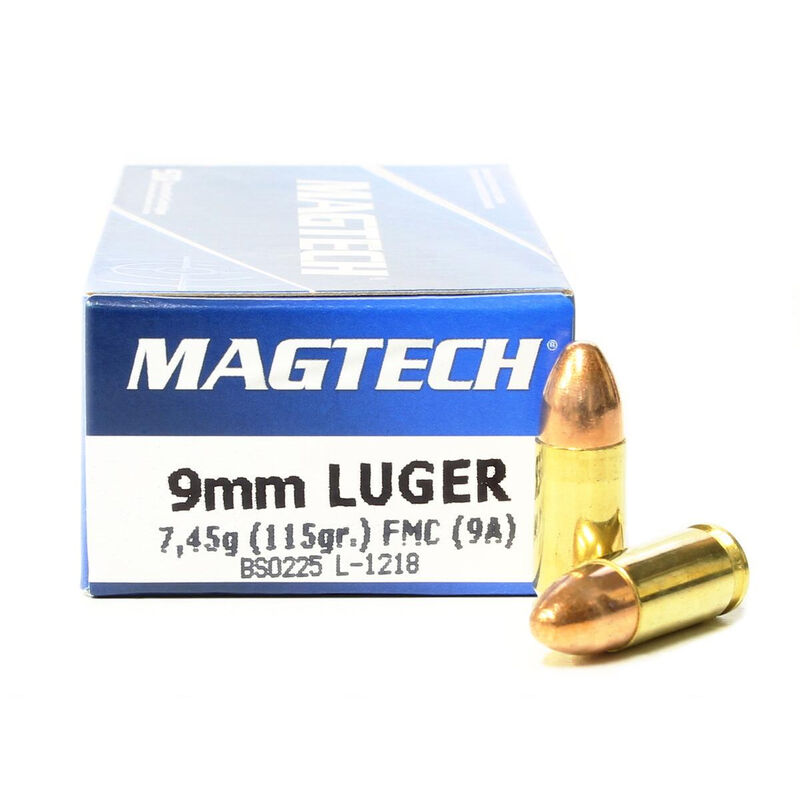Buy 9mm Ammo Online
All the Different Types of 9mm Ammo Explained Here
The 9mm Luger is one of the most popular centerfire pistol cartridges globally and has seen widespread adoption by law-enforcement agencies and militaries. However, what are the different types of 9mm ammo?

9mm Cartridges
If you’re new to firearms or ammunition, the number of 9mm cartridges can be overwhelming. Are they all the same? What is the difference between 9mm and 9mm Luger ammo?

While the 9mm Luger cartridge is often simply called “9mm,” there are a variety of 9mm cartridges on the market today. Two of the most popular rounds, which are not interchangeable, include:
9×17mm Browning
This is the metric designation for the popular .380 ACP cartridge, introduced in 1908, also known as 9mm Short, 9mm Kurz, and 9mm Corto. The .380 is used in compact and subcompact semi-automatic pistols for self-defense.
9×18mm Makarov
Adopted by the Soviet Union in 1951, the 9mm Makarov is a semi-automatic pistol and submachine-gun cartridge. It takes its name from the blowback-operated Makarov PM. Although the casing is only one millimeter shorter than the 9×19mm Luger, the ammunition is not interchangeable. The bullet is also slightly larger in diameter. Ballistically, the Makarov is equivalent to +P .380.
In Europe, the .38 Special is designated 9×29mmR, further adding to the list.
9mm Luger History
The 9mm Luger cartridge has been in civilian and military use for more than 115 years. The cartridge has several designations—9×19mm, 9mm Parabellum, 9mm Luger, 9mm NATO, and simply 9mm. These all refer to the same round.
It’s popularly called the 9mm Luger because Georg Luger, the designer of the eponymous semi-automatic pistol, designed the cartridge, introducing it in 1902. Luger developed the 9mm cartridge by necking down the 7.65×21mm Parabellum cartridge and demonstrated this new round to the British Small Arms Committee and the American Springfield Armory the following year.

Today, the 9mm cartridge dominates law enforcement and military sidearms. The round is lightweight, comfortable to shoot, lends itself to high-capacity staggered-feed magazines, and exhibits satisfactory terminal performance.
Outside of semi-automatic pistols, the 9mm is one of the most popular submachine-gun cartridges in the world, appearing in such famous weapons as the IMI UZI and HK MP5.
The 9mm cartridge has a 19mm-length cartridge casing, hence the full metric designation. In inches, the bullet’s approximate diameter is .355.
Bullet Weight
While ammunition manufacturers load 9mm cartridge casings with a wide variety of different weight bullets, the three most common are 115, 124, and 147 grains. The grain is a common unit of measurement in the United States for bullets and propellant powder charges, equal to 1⁄7000th of a pound. In the metric system, it takes 15.43 grains to equal one gram.
Most 9mm pistol loads are supersonic—they exceed the speed of sound—however, cartridges loaded with 147-grain bullets tend to be subsonic. Subsonic 9mm loads are useful for optimizing the performance of sound suppressors, eliminating the miniature sonic boom that increases the decibel rating of firearms. In unsuppressed firearms, the heavier bullet can penetrate more deeply in soft tissue than some lighter alternatives.
Bullet Types
9mm cartridges are available in dozens of loads, but the most common bullet types are:
1. Full Metal Jacket (FMJ)
9mm full metal jacket (FMJ) or ball ammunition is mostly used in a civilian context—by private citizens and law-enforcement personnel—for training and range practice. Non-deforming FMJ bullets feed reliably in semi-automatic pistol designs and are relatively inexpensive. Specialty ballistic performance is not required—the bullet simply has to punch holes in paper targets or shatter against steel plates.
In a military setting, 9mm FMJ ammunition is used in sidearms and submachine guns either to comply with the Hague Conventions of 1899 and 1907 or as a general practice. FMJ bullets are more penetrative than the deforming varieties in a defensive or combat setting. This may be a positive or a negative depending on the tactical realities of the environment and target.
2. Jacketed Hollow Point (JHP)
For anti-personnel or defensive applications, jacketed hollow-point ammunition is preferred. FMJ ammunition is more penetrative because it does not expand in the target medium. This, however, limits the terminal performance of the bullet and can cause the bullet to exit the intended target, posing an additional risk to bystanders. Consequently, private citizens and law-enforcement personnel tend to carry JHP ammunition in 9mm pistols and carbines.
The JHP bullet has a cavity in the nose. When the target medium enters this cavity, it creates a buildup of pressure in the pit, which forces the surrounding core and jacket to expand outward. This tends to cause the bullet to “mushroom.” The resulting increase in the frontal surface area increases the diameter of the permanent wound cavity. It also transfers more kinetic energy to the target, which increases temporary wound cavitation and reduces penetration.
Many JHP bullet designs have factory-scored jackets. This scoring promotes the expansion of the jacket into a series of petals.
3. Frangible
If you want to increase range safety, you can choose to fire frangible loads. These bullets are designed to undergo complete disintegration on impact with steel range targets, reducing the probability of fragments posing a threat to you or fellow range attendees. Some frangible bullets can be useful for shooting pests or hunting varmints; however, they are often inappropriate for defensive applications against humans.
Stopping Power
For years, gun owners maligned the 9mm cartridge as possessing inadequate stopping power due to its relatively lightweight bullets and medium caliber. The tapered, round-nosed full metal jacket was less disruptive in soft tissue than its .45-caliber alternative, and the 9mm didn’t pack the energy of the .357 Magnum. Furthermore, being a semi-automatic pistol cartridge, it couldn’t use the more efficient full and semi-wadcutter bullets reliably.

In the 1970s and ‘80s, 9mm JHP bullets were not as reliable or robust as today, which led many gun owners to assert that the .45 ACP was the superior caliber. The reasoning was that, while a 9mm JHP might expand, a .45 ACP FMJ couldn’t shrink.
Insufficient penetration and inadequate permanent wound cavitation in real-world experience and testing led the FBI to select the 10mm Auto cartridge for adoption by its field agents.
However, more recently, the FBI switched to the 9mm, arguing that ammunition technology had progressed significantly in the intervening years. The 9mm Luger had become a viable self-defense and duty cartridge.
When selecting ammunition for self-defense, you should be able to answer the question: “What is the difference between 9mm and 9mm Luger ammo?” Only buy the 9mm ammunition that fits your particular gun and serves the purpose that you need it to.
buy guns online | guns and ammo | buy ammo online | ak47 for se | guns for sale online |
Let us also talk about something else on this post. I will like to site one of the best mushroom shop in the US. Visit one of the largest magic mushroom shop with the selection of magic mushrooms, fresh magic truffles, mushroom carts, mushroom chocolate bar and magic mushroom grow kits. https://themagicmushroomcenter.com/
buy magic mushrooms
where to buy magic mushrooms
buy magic mushrooms online
magic mushrooms for sale

